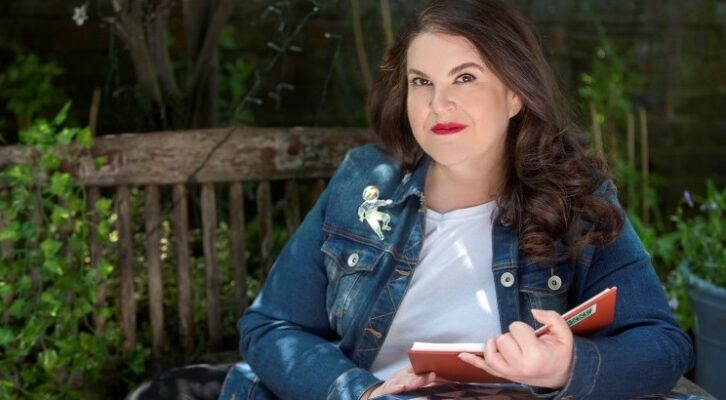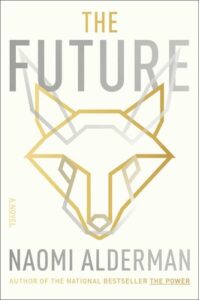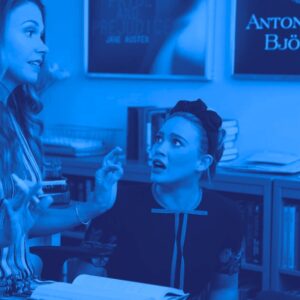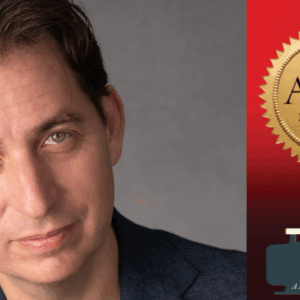
Naomi Alderman on Creating a Fictional Tech Dystopia
Jane Ciabattari Talks to the Author of The Future
Naomi Alderman made her mark as a speculative fiction genius with her fourth novel, The Power, in which young women had the power to send electricity from their fingertips, flipping the gender equation (“Already there are parents telling their boys not to go out alone, not to stray too far,” Alderman writes). It was written during a mentorship with Margaret Atwood, whose The Handmaid’s Tale helped set Alderman’s course as a writer.
The Power won the 2017 Women’s Prize for Fiction, and launched this year as a streaming series, with Alderman as a screenwriter. Alderman continues to examine the uses and abuses of power with edgy wit in The Future, a galvanizing follow-up, an end-times narrative that asks, Is it possible for those with power to use it for the good of all? Our email conversation connected us in Sonoma County and London.
*
Jane Ciabattari: How have you managed during these tumultuous times? To what extent was The Future inspired by the Covid pandemic?
Naomi Alderman: Oh I’ve done alright. I am incredibly lucky that my job involves sitting on my own in a room and not driving a bus, so I got through the pandemic with probably the average level of mental trauma. Which I think is very underdiscussed. We’re all still in the post-traumatic phase. My mother died this March though—she had a stroke on the day of The Power premiere and her funeral was the day the show was released. So it’s been a very strange and hard year.
Annoyingly I was working on The Future long before the pandemic! I had a full draft completed at the end of 2019 and was going to get to work polishing it. It used to start with fifty pages of pandemic—I had thought “ah, we haven’t had one of these since 1918 so we’re sort of due.” And then at the start of 2020… well, you know. In March 2020 I thought the novel was lost completely. Who would want to read that? By 2021 I started to find a new way through.
When you sit and try to meditate, you find your mind constantly going between the past and the future.
JC: Your opening sentence is a spot-on: “On the day the world ended, Lenk Sketlish—CEO and founder of the Fantail social network—sat at dawn beneath the redwoods in a designated location of natural beauty and attempted to inhale from his navel.” Why start there?
NA: Thank you! In essence this is the question about the future. What is it that we find so hard as a species about being in the present moment. When you sit and try to meditate, you find your mind constantly going between the past and the future. So this sentence begins (what I intend to be at least!) a funny scene where Lenk tries to meditate but his mind keeps wandering to his aims, his ambitions, his anger with the limitations of the present moment. He is intensely focused on his navel, as in navel-gazing. But he’s also confronting the central problem of the novel, which I think is a central problem of humanity: how to deal with the fact that we can’t truly know what’s going to happen even one second into the future. And how not being able to deal with it makes things a lot worse.
And you know, if your novel gives you the opportunity to start with “on the day the world ended” I think you probably should do that.
JC: Lenk is one of a triad of narcissistic tech billionaires—with Ellen Bywater, who runs Medlar Technologies and Zimri Nommik, head of Anvil, the “logistics and purchasing giant”—at the center of the failing world in The Future. Who inspired these characters?
NA: Hahaha. They were definitely not inspired by anyone specifically who could sue me for everything I’m worth and barely notice it, if that’s what you’re asking. They are composite characters made up of some of the ridiculous and awful things that tech billionaires have done and some of it just made up out of my head. But of course the companies are inspired by real companies.
JC: In this dystopian universe, these tech titans are separate from the rest of the world because they have set up “intense survival bunkers” so they will live even when the world ends. I’m curious about how close this plan is to reality? Do real world tech billionaires have such plans in place? Is it possible? If not, soon?
NA: Oh this is already happening, it’s been widely reported. Read Survival of the Richest by Douglas Rushkoff. Or Evan Osnos’ New Yorker piece Doomsday Prep for the Super-Rich which was published in 2017 and started me thinking about this novel.
JC: The counterpoint to these three powerful egos is a team of four “of one mind” tech wizards who are able to stand up to the powerful three and try to shift the value system toward preservation and community—Martha Einhorn, Lenk’s assistant, the child of a survivalist fundamentalist cult leader named Enoch; Badger Bywater, Ellen’s rebellious nonbinary youngest child; Albert Dubroswki, the ousted founder of Medlar; and Selah Nommik, Zimri’s wife and a brilliant coder. Are there prototypes for these characters?
NA: I have met so many good people working in tech. I would say that is the majority—as it’s the majority in most places. In tech there are so many people who really joined these companies because they were excited about doing excellent work and creating things that would really help humanity and the world. If all of those people were simply to refuse to create the products that do so much harm—or insist on retooling them so they were less extractive and thieving—things would change very quickly.
JC: Lai Zhen, who has parlayed her childhood survival of the Fall of Hong Kong and years in a refugee camp into a role as a survivalist influencer, has a brief intense love tryst with Martha in the midst of a tech conference. This disrupts their lives, and transforms Zhen into the central narrator of The Future. In a novel with eight key protagonists, which came first?
NA: Hahah. Oh god in the first draft of this novel I think there were more protagonists than that! I’ve never written a book in this way before—it came in individual scenes with interesting characters where I didn’t know how it was going to fit together at all, I just knew that those scenes were all somewhere in the same book. So Zhen was always fleeing in the mall in Singapore. Martha was always meeting Lenk Sketlish at a party in Silicon Valley. And in even the earliest drafts—where they were called something different—they were going on a date that went unexpectedly well. I just had to figure out all the other bits!
JC: Part of your narrative unfolds through the “Name the Day” survivalist forum, which includes Martha as OneCorn. The forum offers Bible study focused on Sodom and Gomorrah and the story of Lot, his daughters, and his wife (who is turned to salt) along with survivalist advice for a new generation of Enochites. What drew you to include this biblical story in the tech forum and your plot?
If you were never the kind of person who knew how to care for a community, you’re not going to suddenly become that when your city is destroyed.
NA: When I started thinking about the billionaires in their bunkers I thought immediately of Lot. Of course, I grew up reading the Bible in the original Hebrew, so I have a lot of literacy in those ancient stories! Lot is a man who lives in a terrible place, a place on the edge of destruction, and who believes that he and his family can escape that destruction and be safe.
The story of their family—including the wife turning into a pillar of salt—is of the ways that the callousness of believing that you can get away absolutely fine while others perish will itself eventually destroy you. Lot doesn’t try to help anyone in that city outside his family, doesn’t try to warn them, doesn’t try to influence them to be different. He and his two daughters end up living in a cave and…it doesn’t go brilliantly. If you were never the kind of person who knew how to care for a community, you’re not going to suddenly become that when your city is destroyed.
JC: Throughout this novel, especially in the scene in Zhen’s friend and mentor Marius’s classroom in Budapest, when he’s explaining machine learning (“Human learns. Machine iterates,” he points out), I wondered how many years of training in the internet/digital world you’ve had, and how much research you needed to do to build the worlds you do in The Future.
NA: So! I have worked in videogames in parallel with my career as a novelist. I love it. Videogames is a wide open field with so many novel solutions yet to be discovered to complex and interesting narrative problems. It’s an exciting place to work and think. So I understand why a person like Martha, a serious person with a difficult life history, would end up working in technology. In terms of understanding how machine learning works—I think I learned this in a BBC program from about 1992! I realized it was constantly in my mind when I was thinking about the novel so I thought: well, I should find a way to have it in the book. Marius was already in the novel so I thought he’d do it in an entertaining way!
JC: Your plot is complicated, and involves an app called AUGR (both an “augur” and an “auger”), life-preserving suits of armor, aka digital pathways. How has your work as a gamer (including the Zombies, Run! app you developed in 2011) had a role in your plotting? (In 2011 you wrote about “storytelling in short arcs,” and this: “Writing-craft geekery: four or five sections is how US TV dramas are often divided up, which interests me. It’s a good number. Teaser, plus three or four ‘acts’.”)
NA: Definitely working in games has taught me how to write very plotty, propulsive work. I do think that in this world of Netflix, Playstations, social media, that readers deserve a bit of help with a novel, and I like to write things that have a lot of serious stuff going on but are also page-turners.
JC: You have spoken about being influenced by Margaret Atwood, including being mentored by her while writing The Power. Has the Atwood influence continued? Are there echoes in The Future?
NA: The Atwood influence will always be with me. She is wonderful and we’re still good friends. I think certainly her influence is there in my being willing to keep on taking on subjects on a wide canvas, to weave together the real and the imaginary, to never lose sight of humor.
JC: What are you working on now/next?
NA: Well. A new book is emerging. I am unexpectedly working on something about my mother, and about the contradictions of her life. It’s a book in which my mother has died and also there is a strange new animal that’s appeared in the UK. I didn’t decide to start writing, and when I did start I thought it would be a short story. But it keeps growing and growing.
__________________________________

The Future by Naomi Alderman is available from Simon & Schuster.
Jane Ciabattari
Jane Ciabattari, author of the short story collection Stealing the Fire, is a former National Book Critics Circle president (and current NBCC vice president/events), and a member of the Writers Grotto. Her reviews, interviews and cultural criticism have appeared in NPR, BBC Culture, the New York Times Book Review, the Guardian, Bookforum, Paris Review, the Washington Post, Boston Globe, and the Los Angeles Times, among other publications.



















